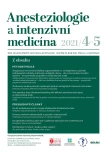Evaluation of patients referred to brain death scintigraphy
Authors:
M. Havel 1; D. Školoudík 2; D. Nováková 1; P. Švec 3; P. Havránek 3; G. Havlová 1; O. Kraft 1; V. Dedek 1; K. Bukovanský 1; R. Drozdková 1; P. Širůček 1
Authors‘ workplace:
Klinika nukleární medicíny, Fakultní nemocnice Ostrava a Lékařská fakulta, Ostravská univerzita
1; Centrum zdravotnického výzkumu, Lékařská fakulta, Ostravská univerzita
2; Transplantační centrum, Fakultní nemocnice Ostrava
3
Published in:
Anest. intenziv. Med., 32, 2021, č. 4-5, s. 197-203
Category:
Original Papers
Overview
Objective: The aim of this work is to analyse data of brain death scintigraphy examinations performed within one centre
retrospectively. We focused on the differences between examined children and adults, including proportions of coma
causes or organ donors. The cases with negative scintigraphic finding were further assessed.
Design: Retrospective.
Setting: Nuclear Medicine Department, University Hospital.
Material and methods: A total of 320 patients between years 2003 and 2020 were examined (mean age 44 ± 18 years,
207 men, 113 women). The group was divided according to age into patients under 18 years (40, Group A) and those with
age higher than or equal to 18 years (280, Group B), these groups were compared for the causes leading to coma and for
the rate of organ donors.
Results: A finding demonstrating cerebral aperfusion was recorded at 95% of patients during the first examination.
The groups differed significantly in the causes leading to coma, cerebrovascular accidents formed only 10 % of Group
A, in contrast to Group B with dominating cerebrovascular accidents and trauma plus other external causes (48 %,
43 % respectively, P < 0.0001). There were also significant differences in the proportions of patients who were not organ
donors, they were significantly more frequent in Group A (55 % vs. 11 %, P < 0.0001), they have different proportions of
causes leading to coma, with minority of cerebrovascular accidents (13 %, P < 0.0001).
Conclusion: Brain perfusion scintigraphy is an available and usable method standardized in the brain death diagnosis.
There are differences in the proportions of coma causes and of subsequent organ donors to transplant in childhood and
adulthood.
Keywords:
Transplantation – Radionuclide imaging – brain death – perfusion imaging
Sources
- Randell TT. Medical and legal considerations of brain death. Acta Anaesthesiol Scand. 2004; 48(2): 139–144.
- Česko. Zákon č. 285/2002 Sb. ze dne 30. května 2002 o darování, odběrech a transplantacích tkání a orgánů a o změně některých zákonů (Transplantační zákon). Česká republika: Sbírka zákonů; 2002.
- Standardy zdravotní péče – „Národní radiologické standardy - nukleární medicína“. Soubor doporučení a návod pro tvorbu místních radiologických postupů (standardů) na diagnostických a terapeutických pracovištích nukleární medicíny v České republice. Věstník Ministerstva Zdravotnictví České republiky. 2016; 2016(2/2016): 203–364.
- Beecher HK. A Definition of Irreversible Coma: Report of the Ad Hoc Committee of the Harvard Medical School to Examine the Definition of Brain Death. JAMA J Am Med Assoc. 1968; 205(6): 337–340.
- Goila AK, Pawar M. The diagnosis of brain death. Indian J Crit Care Med. 2009; 13(1): 7–11.
- Kapucu ÖL, Nobili F, Varrone A, Booij J, Borght TV, Nagren K, et al. EANM procedure guideline for brain perfusion SPECT using 99 m Tc‑labelled radiopharmaceuticals, version 2 Background and definitions. Eur J Nucl Med Mol Imaging. 2009; 36(12): 2093.
- Zerarka S, Pellerin L, Slosman D, Magistretti PJ. Astrocytes as a Predominant Cellular Site of 99mTc‑HMPAO Retention. J Cereb Blood Flow Metab. 2001; 21(4): 456–468.
- Conrad GR, Sinha P. Scintigraphy as a confirmatory test of brain death. Semin Nucl Med. 2003; 33(4): 312–323.
- Weckesser M, Schober O. Brain death revisited: Utility confirmed for nuclear medicine. Eur J Nucl Med. 1999; 26(11): 1387–1391.
- Medlock MD, Hanigan WC, Cruse RP. Dissociation of cerebral blood flow, glucose metabolism, and electrical activity in pediatric brain death. J Neurosurg. 1993; 79(5): 752–755.
- Rizvi T, Batchala P, Mukherjee S. Brain Death: Diagnosis and Imaging Techniques. Semin Ultrasound, CT MRI. 2018; 39(5): 515–529.
- Tomek A, Školoudík D, Škoda O, Neumann J, Šaňák D, Mikulík R, et al. Metodika stanovení smrti mozku pomocí transkraniální sonografie vypracovaná Neurosonologickou komisí a Cerebrovaskulární sekcí České neurologické společnosti ČLS JEP. Česká a Slov Neurol a Neurochir. 2016; 79(5): 608–611.
- Odbor statistiky obyvatelstva Český statistický úř ad. Vývoj úmrtnosti v České republice za období 2006-2016. 2017.
- Janoušek S, Kukla L, Sedlak P, Roth Z, Zvadová Z, Vignerová J, et al. Dětská úrazovost v České republice v období let 2009 a 2010. Čes‑slov Pediat. 2011; 66(3).
- Bruthans J. Epidemiologie a prognóza cévních mozkových příhod. Remedia. 2009; 19(2): 128–131.
- Rodrigue JR, Cornell DL, Howard RJ. Pediatric organ donation: what factors most influence parents’ donation decisions? Pediatr Crit Care Med. 2008; 9(2): 180–185.
- Česko. Vyhláška č. 113/2013 Sb. ze dne 7. května 2013 o stanovení bližších podmínek posuzování zdravotní způsobilosti a rozsahu vyšetření žijícího nebo zemřelého dárce tkání nebo orgánů pro účely transplantací (vyhláška o zdravotní způsobilosti dárce tkání a orgánů pro účely transplantací). Česká republika: Sbírka zákonů; 2013.
Labels
Anaesthesiology, Resuscitation and Inten Intensive Care MedicineArticle was published in
Anaesthesiology and Intensive Care Medicine

2021 Issue 4-5
Most read in this issue
- Upper airway and esophageal burn injury
- Pooperační únavový syndrom
- Prophylaxis of venous thromboembolism in critically ill patients
- Nové zkušební otázky k atestaci
